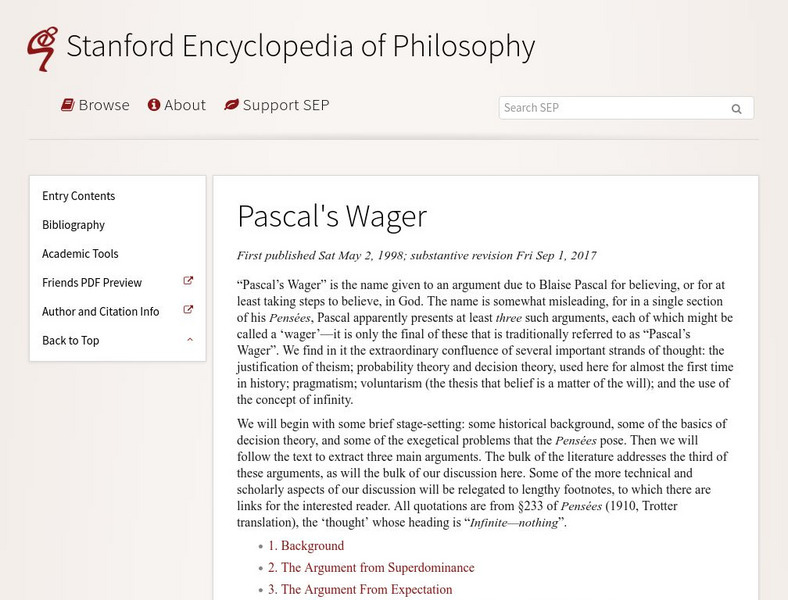Probability Theory Teacher Resources
Hi, What do you want to do?
Find Probability Theory lesson plans and worksheets
Showing 240 resources
Other
Schaum's Outlines: Probability and Statistics
This comprehensive study guide contains 897 fully solved probability and statistics problems with explanations. Topic covered includes basic probability, sampling theory, regression, and more.
Khan Academy
Khan Academy: Bertrand's Paradox
In this Wireless Philosophy video, Jonathan Weisberg (University of Toronto) explains Bertrand's Paradox, a famous paradox in probability theory. Beginning with the square factory example, he talks about how Bertrand's Paradox reveals a...
Illustrative Mathematics
Illustrative Mathematics: S cp.a.2/a.3/a.5 and S cp.b.7: Rain & Lightning
This task uses the same situation to explore different concepts of probability theory. Aligns with the S-CP.A.2.; S-CP.A.3; S-CP.A.5; and S-CP.B.7 standards.
University of St. Andrews (UK)
University of St. Andrews: John Venn
Good introduction to Venn's life and work. Explains especially his lifelong relationship to Cambridge. Includes links to further information on Venn's "probability theory."
Stanford University
Stanford Encyclopedia of Philosophy: Pascal's Wager
This site from the Stanford Encyclopedia of Philosophy discusses the philosophical and logic merits of Pascal's Wager, as well as the objections against it. Begins with a short historical and philosophical background to put the Wager in...
TED Talks
Ted: Ted Ed: Peter Donnelly Shows How Stats Fool Juries
Peter Donnelly discusses probability theory and statistics in real-world scenarios in this video. [21:25]
Mathigon
Mathigon: Combinatorics: World of Math
This lesson focuses on Combinatorics, a branch of mathematics which is about counting. It includes 5 sections: Factorials, Permutations, Combinations, Combinatorics and Pascal's Triangle, and Combinatorics and Probability with examples...
Khan Academy
Khan Academy: Fundamentals: Bayes' Theorem
In this Wireless Philosophy video, Ian Olasov (CUNY) introduces Bayes' Theorem of conditional probability and the related Base Rate Fallacy. [6:20]
Wolfram Research
Wolfram Math World: World's Most Extensive Mathematics Resource
MathWorld provides a huge mathematics encyclopedia detailing the concepts of geometry, algebra, calculus, discrete math, number theory, and other math topics--complete with formulas, diagrams, examples, and references for thorough...
Khan Academy
Khan Academy: Journey Into Information Theory: Origin of Markov Chains
Introduction to Markov chains.
Interactive Mathematics
Interactive Mathematics: Independent and Dependent Events
This tutorial explains how to distinguish between independent and dependent events. Several examples are provided to find the probability of each type of event.
Sophia Learning
Sophia: Experimental and Theoretical Probability: Lesson 4
This lesson discusses the difference between probability in theory and in practice. It is 4 of 5 in the series titled "Experimental and Theoretical Probability."
Illustrative Mathematics
Illustrative Mathematics: S cp.b.9: Alex, Mel, and Chelsea Play a Game
Alex, Mel, and Chelsea play a game that has 6 rounds. In each round there is a single winner, and the outcomes of the rounds are independent. For each round the probability that Alex wins is $\frac{1}{2}$, and Mel is twice as likely to...
Ministry of Education and Universities of the Region of Murcia (Spain)
Ministerio De Educacion Y Ciencia: El Azar Y La Probabilidad.
In Spanish. This is an interactive activity which introduces the basic concepts of probability theory. This unit ends with a first look at the probability of compound events.
Texas Instruments
Texas Instruments: Numb3 Rs: Filtering Suspects
Based off of the hit television show NUMB3RS, this lesson introduces students to the concept of conditional probability (with a couple of references to Bayesian filtering). The lesson is framed in the context of a series of suspects who...
Texas Instruments
Texas Instruments: Numb3 Rs: Lost and Found
Based off the hit television show NUMB3RS, this lesson introduces students to chaos theory, and specifically Levy flight paths. These allow students to "trace back" where an object may have originated, given its endpoint. This lesson is...
University of St. Andrews (UK)
University of St. Andrews: George Polya
This University of St. Andrews site offers a biography of George Polya. Many links are provided.
University of St. Andrews (UK)
University of St. Andrews: Jacob (Jacques) Bernoulli
This site, which is provided for by the University of St. Andrews, contains information on the life of Bernoulli.
University of St. Andrews (UK)
University of St. Andrews: Georges Louis Seclerc Comte De Buffon
This University of St. Andrews site contains a brief overview of this mathematician's accomplishments.
Wolfram Research
Wolfram Math World: Sets
This page discusses sets and set theory in mathematics and probability, and it discusses the notation and properties of sets.
US Holocaust Memorial Museum
U.s. Holocaust Memorial Museum: Protocols of the Elders of Zion: Timeline
A chronology of the conspiracy theory deliberately created in a book, probably by Russian secret police in the late 19th century, and how that text has been used in the last 100+ years by various groups to justify antisemitic actions.
Rice University
Hyper Stat Online Statistics Textbook: Trend Analysis
A series of pages that help us understand testing one or more components of a trend using specific comparisons, a set of coefficients, error analysis of variance and the probability value.
TeachEngineering
Teach Engineering: It's a Connected World: The Beauty of Network Science
Students learn about complex networks and how to use graphs to represent them. They also learn that graph theory is a useful part of mathematics for studying complex networks in diverse applications of science and engineering, including...
University of St. Andrews (UK)
University of St. Andrews: Christiaan Huygens
This University of St. Andrews site contains biographical information and findings of Christiaan Huygens.




















